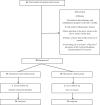The quality of physiotherapy and rehabilitation program and the effect of telerehabilitation on patients with knee osteoarthritis
- PMID: 36279075
- PMCID: PMC9589787
- DOI: 10.1007/s10067-022-06417-3
The quality of physiotherapy and rehabilitation program and the effect of telerehabilitation on patients with knee osteoarthritis
Abstract
Objective: To compare the effects of telerehabilitation vs home-based exercise programs for knee osteoarthritis (KOA).
Method: Patients diagnosed with moderate/mild KOA were enrolled in the study and randomized into two groups. The patients in the telerehabilitation group did their exercises via video conference simultaneously, accompanied by a physiotherapist, while the patients in the control group were given a brochure showing how to do the exercises and explaining how to do each exercise. Patients completed 30-s chair stand test (30 CST), Knee Injury and Osteoarthritis Outcome Score (KOOS), Numeric Rating Scale (NRS), International Physical Activity Questionnaire Short Form (IPAQ-SF), Hospital Anxiety and Depression Scale (HADS), TAMPA Kinesiophobia Scale (TKS), Fatigue Severity Scale (FSS) twice before and after 8-week treatment, and Quality Indicators Questionnaire for Physiotherapy Management of Hip and Knee Osteoarthritis (QUIPA) and Exercise Adherence Rating Scale (EARS) after treatment only. Moreover, the number of painkillers that patients used in the last 15 days was recorded before and after treatment, and patient satisfaction with treatment was questioned after treatment.
Results: Forty-eight patients were included in the study. The mean age of patients was 55.83 ± 6.93 years, and 43 (89.6%) patients were women. No significant differences were determined between groups in terms of baseline characteristics. After the 8-week follow-up, telerehabilitation group demonstrated better 30 CST, IPAQ-SF, KOOS, QUIPA, treatment satisfaction, and total and C subscale of EARS scores increment and greater NRS, HADS, TKS, and FSS score reduction than the control group. It was determined that there was a statistically significant difference between the telerehabilitation and control groups for all of the specified parameters; however, no statistically significant difference was found for the B subscale of EARS.
Conclusion: This study indicated that telerehabilitation is superior to self-management. Moreover, through this innovative and population specific web-based approach for KOA, a vast number of patients who have internet access could be reached. Thus, patients with KOA received effective treatment.
Keywords: Digital treatment; Exercise; Web-based intervention; eHealth.
© 2022. The Author(s), under exclusive licence to International League of Associations for Rheumatology (ILAR).
References
-
- Bernetti A, et al. Evaluation of the efficacy of intra-articular injective treatment with reticular hyaluronic acid (Mo. Re. Technology) in amateur athletes with over-use gonarthrosis. Med Sport. 2020;73(1):127–39. doi: 10.23736/S0025-7826.20.03648-0. - DOI
Publication types
MeSH terms
LinkOut - more resources
Full Text Sources
Medical


